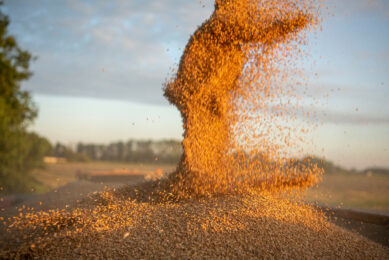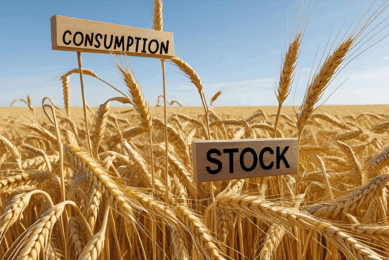Global wheat production in balance despite big fluctuations
The 2009/10 projection for world wheat production is increased by 2.8 million tonnes this month, to 659.3 million.
US production is increased by 1.9 million tonnes, while foreign production is up by 0.9 million tonnes to 599.9 million.
This very small increase in foreign production is a result of sizeable offsetting changes in a number of countries.
Considerable production increases for India, EU-27, China, Ukraine, and several other countries are largely offset by substantial drops in production for Russia, Argentina, Canada, Kazakhstan, and South Africa.
Global wheat average yield and production is projected to be the second-highest in history after the exceptional 2008/09 marketing year.
Large increase in India
The largest increase is projected in India, where most of the crop was harvested months ago. The 2009/10 wheat production is increased by 3.0 million tonnes to the historical record of 80.6 million based on revised final government estimates.
Wheat production in the EU-27 is projected up 1.6 million tonnes to 136.3 million.
There are still problems with relentless dryness in Spain, Romania, Bulgaria, and Austria where production is further reduced by 0.8, 0.2, 0.2, and 0.1 million tonnes, respectively.
In Germany, Poland, and France timely rains and ample soil moisture created excellent crop conditions and higher than expected yields.
Ukrainian wheat production prospects increased 1.0 million tonnes this month to 19.5 million following consistently good harvest reports indicating higher-than-expected yields, despite certain adverse weather conditions in the eastern part of the country.
China: harvest up, quality down
China’s wheat production is also up 1.0 million tonnes to 114.5 million, the second highest wheat production on record, and an increase of 2.0 million tonnes from 2008/09.
Most of the crop (winter wheat) has already been harvested with both area and yields higher than previously projected.
Wheat area and yield increases are based on the local statistical report from Xinjiang province and early indications of production of summer harvested crops by the National Bureau of Statistics. However, wheat quality this year is reported as being low.
Russian harvest down
The biggest drop in wheat production occurred in Russia, where the month-on-month decrease in production reached 4.5 million tonnes, lowering output to 55.5 million.
In July, the increase in the wheat production estimate by 1 million tonnes was driven by revisions in wheat area that appeared to be 1.2 million hectares higher than previously expected.
This month, the revision and reduction in wheat production results from a combination of the latest amendment of area sown for spring grains (the decrease for wheat area estimated at 0.5 million hectares), and persistent dryness in several key wheat-producing areas in the Southern and Volga Valley Federal Districts.
The drought that has spread across those districts has harmed an estimated 3.6 million hectares of grains, mainly by hurting winter wheat during its filling period, and resulted in substantial damage to winter wheat and corn, while also affecting spring wheat yield potential.
Harvest reports as of early August indicate grain yields on average 20% lower than in 2008. Some rain in the south at the end of July came too late to improve grain conditions.
The Russian Ministry of Agriculture is currently assessing the damage and planning compensatory measures.
However, it should be noted that given expected compensation from the national government, regional governments are motivated to overstate local damage.
Siberia compensates
In Siberia, which produces 45% of Russian spring wheat, weather conditions have been pretty good, and appear even better in July.
A combination of better-than-average rain and an increase in spring grain area in Siberia, to some degree, counterbalances the unfavourable situation in the drought-affected regions in the rest of the country, and mitigates the drop in the Russian aggregate wheat production number.
Canadian wheat production is cut further by 1 million tonnes to 22.5 million. The decrease is partly based on a 0.2-million-hectare area reduction resulting from potential for larger than expected area abandonment.
It is highly probable that in the regions most affected by the drought that also have a big cattle industry, such as Alberta, marginal wheat fields will be cut for hay.
Wheat yield also has been reduced, reflecting the larger-than-expected toll on crops from the cold weather. The sluggish pace of crop progress was a related result, as was an increased probability of autumn frost damage.
In Argentina, wheat production prospects are decreased by 1.0 million tonnes to 8.5 million.
Wheat production also has been decreased for Kazakhstan by 0.5 million tonnes to 14.0 million. The decrease reflects dry weather conditions in the western part of the country (bordering the drought-hit southern part of Russia), as well as in the northern part of the country (Kostanai), where wheat in many regions received little or no rain during the moisture critical period.
In South Africa, production prospects are down 0.3 million tonnes to 1.7 million, following release of the first preliminary report on area that showed a 13-percentdrop in planted area from 2008/09.
In addition to a 2.8-million-ton wheat production increase, global supplies are boosted by a 2.15-million-ton increase in 2009/10 beginning stocks this month.
Source: USDA Economic Research Service











